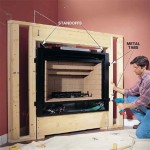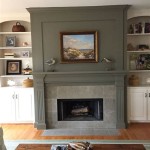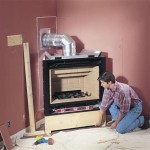Fireplace Brick Veneer: An Aesthetic and Functional Upgrade
Fireplace brick veneer offers a cost-effective and visually appealing method to enhance the aesthetics of a fireplace without the structural demands of a traditional brick fireplace. It involves applying thin slices of brick, known as veneer, to an existing fireplace structure, typically constructed of drywall, concrete, or another suitable material. This approach allows homeowners and builders to achieve the classic look and feel of brick without the expense or complexity of building a full brick surround.
The primary advantage of brick veneer lies in its comparative ease of installation. Because it is lighter and thinner than full-sized bricks, it requires less support and specialized construction techniques. This makes it a viable option for renovations and remodeling projects where adding substantial weight to an existing structure would be problematic. Furthermore, the variety of brick veneer styles, colors, and textures available provides considerable design flexibility, allowing for a customized appearance that complements a range of interior design schemes.
Brick veneer is not solely an aesthetic choice; it also offers certain performance benefits. While not as effective as a solid brick fireplace in terms of heat retention, it does provide some degree of thermal insulation and can contribute to the overall energy efficiency of a room. Moreover, brick veneer is a durable material that can withstand the heat and wear associated with fireplace usage, provided it is properly installed and maintained. The material is also fire-resistant, offering an added layer of safety.
Cost-Effectiveness and Installation Advantages
One of the most compelling reasons to choose brick veneer over solid brick is its cost-effectiveness. The material cost of brick veneer is generally lower than that of full-sized bricks. This is due to the reduced amount of raw materials required to manufacture the thinner veneer slices. Additionally, the installation process is typically less labor-intensive, translating to lower labor costs. A skilled DIY enthusiast might even undertake the project, further reducing expenses. However, professional installation is recommended, particularly for those unfamiliar with masonry or tiling techniques, to ensure proper adhesion and a visually seamless finish.
The installation process typically involves preparing the surface to which the veneer will be applied. This may include cleaning, leveling, and potentially applying a scratch coat to improve adhesion. A thin-set mortar, specifically designed for brick veneer, is then applied to the back of each veneer brick and pressed firmly onto the prepared surface, maintaining consistent spacing between the bricks to allow for grout lines. Once the mortar has cured, the grout is applied, filling the spaces between the bricks and completing the traditional brick appearance.
The lightweight nature of brick veneer also simplifies transportation and handling, further contributing to cost savings. This is particularly relevant for large-scale projects or when dealing with difficult-to-access locations. The reduced weight minimizes the risk of structural issues, particularly in older homes where foundations may not be designed to support the weight of a solid brick fireplace.
Aesthetic Versatility and Design Options
Brick veneer comes in a wide array of styles, colors, and textures, offering unparalleled design versatility. Homeowners can choose from classic red brick, tumbled brick, painted brick, or even options that mimic the appearance of reclaimed brick. This allows for seamless integration with existing décor or the creation of a completely new and distinctive look. The ability to customize the appearance extends to the grout color and joint style, further enhancing the overall aesthetic appeal.
Modern manufacturing techniques allow for the creation of brick veneer that closely resembles natural brick, including variations in color and texture that add to the authenticity. This makes it difficult to distinguish brick veneer from solid brick, especially after installation. This close resemblance provides the desired aesthetic without the added weight or cost associated with traditional brick construction.
Beyond traditional applications, brick veneer can also be used to create unique and modern designs. For example, it can be combined with other materials, such as stone or wood, to create a visually striking fireplace surround. It can also be installed in patterns other than the traditional running bond, such as a stacked bond or herringbone pattern, to add a contemporary touch. The design possibilities are virtually limitless, allowing for a truly personalized fireplace design.
Maintenance and Longevity
Brick veneer, when properly installed and maintained, is a durable and long-lasting material. Regular cleaning is essential to prevent the buildup of soot, dust, and other debris. This can be accomplished with a soft brush and mild detergent. Avoid using harsh chemicals or abrasive cleaners, as these can damage the surface of the brick and the grout.
While brick veneer is inherently fire-resistant, it is important to ensure that the underlying structure is also protected. A properly installed firebox or fire-resistant backing board is crucial for preventing heat damage to the surrounding walls. Regular inspections of the fireplace and chimney are also recommended to ensure that they are in good working order.
The longevity of brick veneer also depends on the quality of the materials used and the workmanship during installation. Choosing high-quality brick veneer and hiring a qualified installer are essential for ensuring a long-lasting and aesthetically pleasing result. With proper care and maintenance, a brick veneer fireplace surround can last for many years, providing both beauty and functionality to the home.

How To Install Thin Brick Veneers On Your Fireplace

Building An Electric Fireplace With Brick Facade

Brick Stone Veneer At Com

Installing Stone Veneer Over A Brick Fireplace Grand River

Grey Is The New Red In Thin Brick Veneer Stone Farm

Brick Veneer Old Towne Mountain View Stone Painted Fireplaces Fireplace

Your Questions About Brick And Stone Veneer Answered Kapstone Masonry

Refacing A Fireplace With Stone Veneer Horizon

Transform Your Home Stone Veneer Over Brick Fireplace Guide

7 Popular Stone Veneer Fireplace Design Trends Mason S Mark
Related Posts








